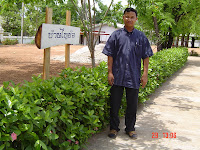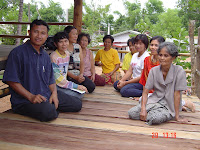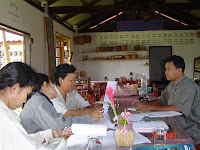



(Collecting data of Nhya Dialect in Nokorn Phnom province by Mr. Chom Sonnang, Mrs. Kallaya Kulsuwan, Mrs. Pariyanant Waiyavech, and Mrs. Kallaya's friend)
Thai or Siamese is the official language of the Kingdom of Thailand. It is one of many languages and dialects belonging to the historical of proto-Tai family, which is divided into three major branches: Northern Tai, Central Tai, and Southeastern Tai. Thai (Siamese) is in the third branch of the family, which also includes the Lao dialects of Laos, the Shan dialects of Upper Burma, several Tai dialects spoken in Yunnan Province in China, such as Tai Leu in Sipsongpana region and Tai Dam, which originated in northwestern Vietnam.
Within Southwestern Tai there is a great deal of mutual intelligibility, these dialects sharing as much as 70% common lexicon. The most distinguishing feature of any dialect is tones - their number, shapes, and historical splits from the three tones of proto-Tai. The maximum number of possible phonemic tones is nine; seven is the highest number of tones within Thailand, namely the variety of Thai spoken in the South. All people in Thailand speak one of the four dialects of Thai. These dialects (Northern, Northeastern, Central, Southern) correspond to the four main geographical areas of Thailand. Official or Standard Thai is based on the idealized speech of the educated elite of Bangkok and large portions of the Central Plain. The other main regional dialects are Northern Thai, spoken around Chiangmai; Northeastern Thai (Isan), spoken to the east of Korat; and Southern Thai, spoken south of Chumpon and into neighboring communities of northern Malaysia.
Isaan is the name given to the North-Eastern region of Thailand, covering 170,218 square kilometers, approximately one third of Thailand’s land area. Nakhon Phanom (นครพนม) is one of the north-eastern provinces of Thailand. Neighboring provinces are (from south clockwise) Mukdahan, Sakon Nakhon and Nong Khai. To the north-east it borders Laos. The province is located at the valley of the Mekong river. The name Nakhon Phanom, meaning "city of mountains", was given to the city by King Rama I. It should be noted that there are actually no mountains in Nakhon Phanom itself; the limestone mountains are concentrated in the city of Thakhet of Laos, which is on the other side of the Mekong. Nakhon Phanom should then mean a city where you can see mountains. The area was long settled by Lao people and belonged to the Lan Xang kingdom. Also after it came under the control of Ayutthaya the population stayed predominantly Lao. The province is, adminstratively, subdivided into 11 districts and one minor district (King Amphoe). The districts are further subdivided into 97 communes) and 1040 villages. The districts are Muang Nakhon Phanom, Pla Pak, Tha Uthen, Ban Phaeng, That Phanom, Renu Nakhon, Na Kae, Si Songkhram, Na Wa, Phon Sawan, Na Thom, and Wang Yang.
Nyaw is spoken in th province of Sokun Nakhon, Nakhon Phanom and some part of Mahasarakham. This study will not cover the language in those area. Specifectly, Nyaw of Nakhorn Phanom province, mainly in Tal (ตาล) village of Tha Uthen District, will be come to account.
Several names are, differently, used to identify the various Yo in both pronunciation and written record. In pronunciation, there are two controversies: Yo /j:/ (written in Thai script (ไทย) ย้อ / ญ้อ ) and Nyaw /ɲ:/. People who speak this language call themselves that /ɲ:/. So in Thai written record, this dialect should be written as ญ้อ. Answer to this, ญ้อ is officially written as Nyaw by SIL (Summer Institute of Languages).
The reasons above, we decide, in orthographic, to use ญ้อ in Thai and Nyaw in Arabic letter.
The reasons above, we decide, in orthographic, to use ญ้อ in Thai and Nyaw in Arabic letter.

3 comments:
I am very interested in your findings on the nyaw language and its speakers. I consider myself a "nyaw" person(the "ny" is pronounced like the "n" in the Spanish word nino) My family is from a village in Cambodia near the Thai/Cambodian border not too far Aranyaprathet. Emails or website to obtain the study results would be most appreciated. My email is loeurng@yahoo.com. Thanks in advance.
I am a nyaw guy. I have nyaw parents. We immigrated from Aranyaprathet, Thailand as Cambodian refugees in early 1980. There are pockets of nyaw communities scattered along the western states and around the world. I have family in Washington, some in Oregon, Florida, Canada, but mostly in California.... I believe the largest population of nyaw people outside of Southeast Asia is in Long Beach, CA... I live Stockton, CA where several nyaw families reside. The rumor about the nyaw people here is that we're all related somehow, through aunts and uncles and 2nd cousins and Marriage and close families that just say they're related... If you're nyaw in the States, chances are my parents know your parents, and your grandparents, and you're probably my cousin, someway, somehow. When I hear someone from another city speaking nyaw, it catches my attention, and it often makes me want to ask who their father or mother is.. I'm really interested in this subject matter, the nyaw or ynaw people are an ethnic minority compared to the Cambodian and the Laos people.... we're right in between, so-to-speak,.. we're an interesting group, and I just want to meet more of us.
hit me up. damdisguy@Hotmail.com
URL... www.myspace.com/donkee
this is very interesting...i'm also a nyaw guy living in the LBC. family was from the province of Battambang, Cambodia...village called "Bhant Tong ma Loang." I've trying to get my mom on video to give me the low down on her early life in the 1940's to the 1970's. i'd like to know stories you guys have from your parents, grandparents...etc. hit me up at bucktavi@hotmail.com
Post a Comment